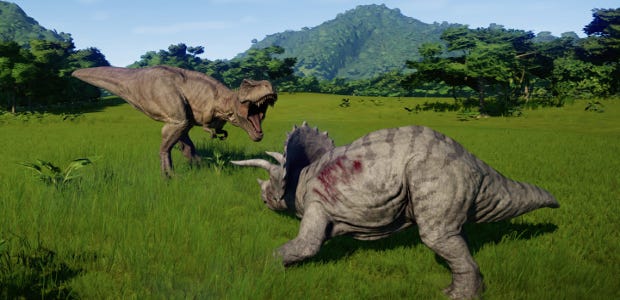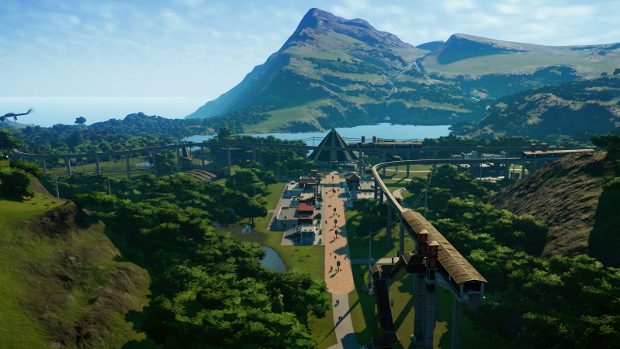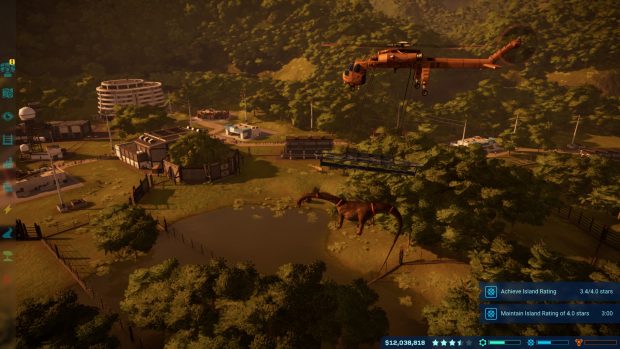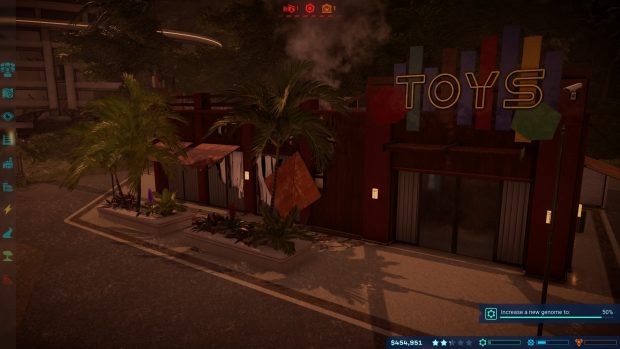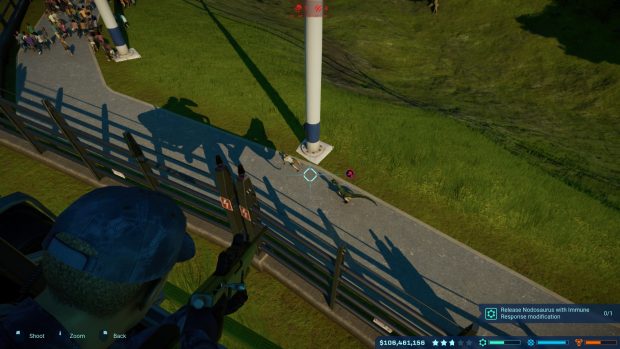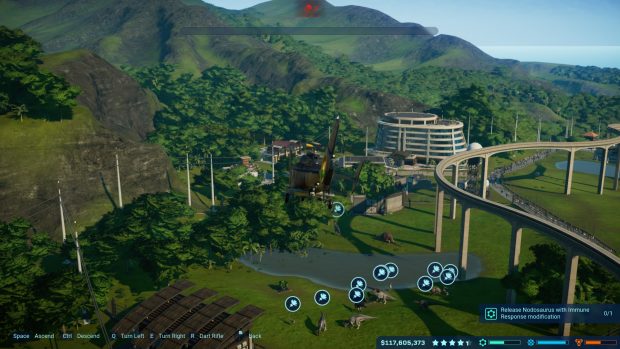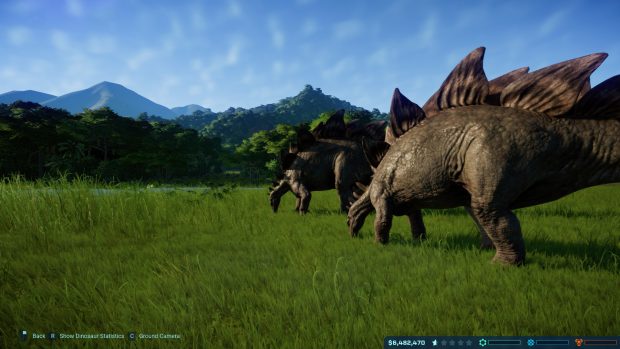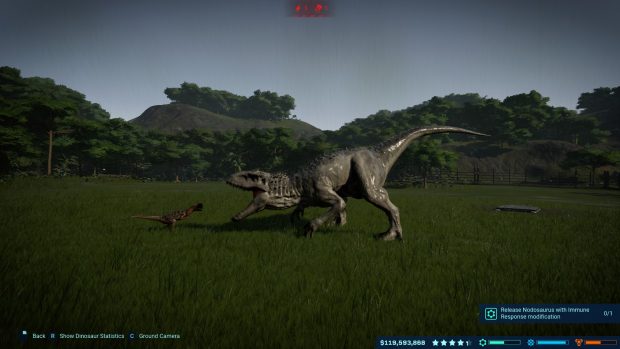Wot I Think: Jurassic World Evolution
Confessions of a dinosaur jailer
I’m not proud to admit that I’ve forced dinosaurs to fight to the death in Jurassic World Evolution. What could possibly lead me to do something so horrible to these wonders of science-fiction? Capitalism, of course. I was being paid, and I needed to buy an ugly fast food restaurant. Every ‘Dino Bite’ that my guests have snacked on has been stained with Velociraptor blood. That’s my guarantee.
My sadness and guilt are especially profound because the dinosaurs are one of the few bright spots in this otherwise humdrum theme park management game.
Set just after the Jurassic World movie, Evolution puts you in the shoes of InGen’s new park administrator as you progress through missions across the Muertes island chain. After two decades, you’d think they’d stop trying to make parks on an archipelago also known as The Five Deaths, but I guess the real estate is super cheap. Each island comes with a specific challenge -- limited space, a mismanaged park that needs saving, foul weather -- but the moment-to-moment experience is dominated by a random assortment of tasks doled out by demanding department heads, dickheads all.
It’s a lot more structured than you might expect from the developer of Elite Dangerous and Planet Coaster. There is a sandbox mode, but it’s only accessible once you get a decent park rating during the campaign, and even then you can only use buildings and tech that you’ve unlocked on the other islands. Frustratingly, it doesn’t really open up until you’ve devoured the entire game.
Evolution does at least avoid some of the pitfalls that other linear management campaigns have fallen into, injecting it with some permanence and cutting out a lot of the repetition that comes from starting over again. All of your research comes with you when you move island, including your list of dinosaur genomes (more on which later). New parks also start with a few buildings and a basic layout, helping you get on your feet a lot sooner. Once you unlock some other islands, you can jump back and forth between them, using new buildings you earned on, say, Isla Sombra to increase your park rating on Isla Muerta.
That it’s the campaign and not a creative mode that’s front and centre is quite telling. Evolution promises to let you build your own Jurassic World, but in truth it’s always going to be InGen’s park. And for InGen, there's only really one way to make a park. While the department heads -- representing science, security and entertainment -- use missions to seemingly offer up three paths, it's all illusory. They aren't separate paths at all, just three lanes you can jump between, all heading in the same direction. There are no real choices, no impetus to specialise.
The modular system that lets you turn a toilet into a pirate ship in Planet Coaster is nowhere to be seen, either, leaving us with only the extremely plain buildings that our bosses at InGen HQ have signed off on. It’s hard to believe that Frontier would ever make another park management game without such a great construction tool. It cut to the heart of the fantasy that these games purport to offer. Running a park is fine, but the real joy is in building it. By taking creativity out the equation, park construction becomes a chore where you’re mostly just fighting against the borders of the map as you try to cram in yet another ugly power station.
Everything really boils down to your park rating and bank account. Placating guests is important, but they’re just a singular group with a unified opinion. There are no demographics or ways to make your park appeal to specific people, and all they want is lots of dinosaurs and amenities. If they get that, you’ll get more customers and more cash.
It’s the dinosaurs you’re meant to care about, not rubbish humans. Evolution might feel like a sterile tie-in at times, but then it produces these wonderful, scaly friends. And unlike your guests, who are just a crowd of nameless nobodies, they’re full of character.
The T.Rex doesn’t play nicely with others. If you put it in an enclosure with other dinosaurs, even another T.Rex, it will most likely try to eat them. You’ve got to respect the single-mindedness of this big, dumb killing machine. You might be OK with that, but dinosaurs cost a lot to make. You have to send out expeditions to find fossils, study the fossils, and then, when you have a workable genome, make the actual dino. Every stage costs cash.
Big ol’ Diplodocus, on the other hand, is a social, friendly dinosaur who gets depressed if it doesn’t have enough pals. The gentle behemoth likes large enclosures with lots of trees, and it’s totally cool with hordes of smaller dinosaurs scurrying around below. It also has a tendency to peek over the fence to say hello to visitors. It’s lovely!
Clicking on them breaks down their traits, requirements and how they’re feeling at that exact moment. These are all reflected in how the dinosaur acts, as well. When I got my first Velociraptor, I gave it a nice big enclosure to play with, full of trees, grassland and multiple sources of food. It got pissed off almost instantly, leading it to make a break for freedom, forcing me to open up the emergency bunker and get a helicopter in the air.
This all took time, though, giving the raptor lots of opportunities for mayhem. As it chased stragglers, a guest fell over. All I could do was gasp, as there was no way my chopper was going to reach them in time. They tried to crawl away, but even on foot there was no escaping the very hungry raptor. It leaped into the air and landed on the poor tourist, claws first. And then it dined.
It was kind of my fault. The Velociraptor is a pack animal, and without a pack, my first raptor was driven insane. Even a hatchery with no upgrades can produce two dinosaurs at once, so I should have released two of them together. Evolution isn’t forthcoming about these details, however. When you select a dinosaur that you want to generate, some bits of key information are missing, so it’s tricky to prepare for a new exhibit.
When I introduced a few more raptors into the enclosure, I hopped in my jeep and headed inside to take a closer look. This is Evolution’s version of going on roller coasters. You can jump into jeeps and helicopters whenever you want, and along with letting you get up close and personal with the dinosaurs, you can also heal or tranquilise ones in distress. The AI can handle these tasks too, but that tends to take a lot longer.
Sitting inside the jeep, I got to watch as the raptors met each other for the first time, greeting their new friends with chirps, clicks and twitches. The quality and range of animation is exceptional, especially in a management sim where you’re mostly getting a bird’s eye view. Dinosaurs within the same family or suborder, like the Velociraptor, Deinonychus and Dilophosaurus (that’s the one that killed poor Dennis Nedry), can look quite similar and share traits, but even then there are noticeable differences. The Dilophosaurus retains its spitting attack and colourful frills from Jurassic Park, for instance, which it loves to show off.
They’re completely wasted on Evolution. This is not, lamentably, another case of a brilliant feature rescuing an otherwise iffy game. The dinosaurs, and by extension their enclosures, are the attractions that all these guests, in their droves, have come to see, but there’s so little you can do with them. An enclosure is simply a fenced in area with grass, trees and some water. The extent of the customisation is some light terraforming and… actually, no, that’s it. There are no props or bits of flair, no way to put your mark on it.
Ultimately, there are two major things you need to worry about: space and visibility. Your guests need to be able to see the dinosaurs from their viewing platforms, while the dinosaurs need a specific amount of grassland and forest to roam around in. All other concerns, like overpopulation, are really just extensions of these primary issues.
When problems do arise, the solution is almost always a combination of adding more trees or grass, more space in general, and throwing some cash at additional places to gawk at stuff. Fine-tuning doesn’t go much beyond placing water and feeders near the platforms, getting dinosaurs closer to their admirers. You’re always going to be building slightly tweaked versions of the same attraction. So that also means no aviary, no places for aquatic dinosaurs, no biomes -- just The Muertes Archipelago’s empty, though admittedly pretty, tropical jungles.
While the dinosaurs do have that long list of needs and personality traits, they only ever lead to the same situations happening over and over again. The dinosaur is happy and thus just hangs out in the enclosure, or it’s angry so it tries to escape the enclosure. The latter happens a lot. It only take one of their needs to go ignored for them to become uncomfortable, and when the comfort level go into the red, it makes a bee line for the fence.
For a game inspired by a series of disaster movies about dinosaurs constantly escaping, Evolution is bizarrely lacking when it comes to security. You can upgrade your fence, but life finds a way. That’s as advanced as it gets, unfortunately. It’s somehow less secure than an ordinary zoo.
Now that I’ve seen it happen 50 times, I’m less enthusiastic than I was when my first raptor got out. It’s always the same. The dino gets angry, I call the chopper in, it usually escapes, I shoot it. It’s not a big deal. While they might snack on a few people, they’re easily stopped and the consequences are fleeting. You might lose some income for a few minutes and take a hit to your park rating, but once you open the shelter doors and people start spending money again, which they do instantly, it will all be forgotten.
Making disasters actually fun to deal with, or at least engaging, is one of the biggest struggles management games have, and so far the few successes have all been games that are built around these disasters rather than using them as some ancillary mechanic or occasional threat. Frostpunk is a great, recent example. Evolution is not. Whether it’s a storm, the electrical grid going down or a dinosaur escaping, it’s only ever a nuisance.
The last movie really doubled down on the “Let’s fuck around with DNA” conceit, and Evolution, as the boring name suggests, continues the trend. While there aren’t many ways to influence your dinosaurs once they’re born, you can design them before you set them loose. The genetics menu lets you bolt on DNA from different animals to improve their traits, making them more resistant to illness or physically stronger. The more you’ve studied the dinosaurs, the more complex you can make them. There’s the hint of an RPG system, inexplicably including its focus on combat.
Most traits make the dinosaurs more dangerous, which makes sense given how chill and non-threatening a T.Rex is normally. It’s all so InGen can pitch their pets to various governments for their military applications, I guess, but that’s not really relevant to me, a park manager. I’ve yet to find a good reason to make the dinosaurs even more deadly. When they fight, you lose a dinosaur either way.
The real reason why you might make these scientific marvels murder each other is because Evolution really, really wants you to. Some fella wearing Star Lord’s face constantly pops up to spout creepy lines about nature and instinct and how he absolutely would sleep with a raptor, while your three department heads will frequently task you with putting the animals in danger.
We’re not talking about nature just taking its course, either. We’re talking about pitting them against each other in battle, picking sides and putting them in dino jail just to see what happens. Whatever you might think about the rights of fictional clones of extinct animals, it’s still exceedingly gross. I can’t build a Triceratops petting zoo, but sure, blood sports, why not?
Evolution suggests that these are ethical conundrums, but it’s all a paper-thin illusion. Aside from the occasional interjection from Dr. Ian Malcolm, whose lines even Jeff Goldblum is incapable of rattling off with conviction, there aren’t any serious consequences to treating the whole place like your nightmarish laboratory. The attempt at critique barely even constitutes as lip service.
Jurassic World Evolution is the most boring of all possible outcomes for a dinosaur theme park sim. There’s no outlet for creativity and, aside from the prehistoric pals you might make, managing the parks just isn’t a lot of fun. By the time I’d unlocked enough to make the sandbox mode live up to its name, I realised I had nothing left to build.
It’s a greater disappointment because it falls so short of Planet Coaster. Frontier has already made the game that shows Evolution where it went wrong. It’s not that Evolution couldn’t have forged its own path, but it throws away lots of proven systems, often without substituting them for anything else. I don’t want to bad-mouth cool dinosaurs, but cool dinosaurs can only carry a game so far.
Jurassic World Evolution is out on June 12 on Windows via Steam for £44.99/$54.99/€54.99.
